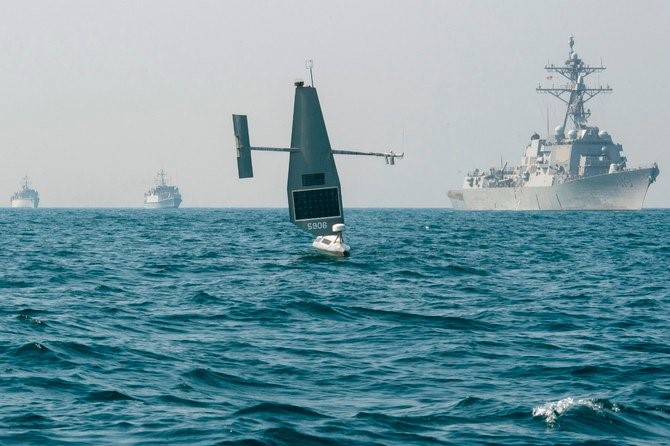DUBAI – The United States Navy performed a combined drone drill with the United Kingdom in the Arabian Gulf on Friday, testing the same unmanned surveillance ships that Iran has seized twice in recent months in the Middle East.
The exercise comes as the US Navy separately informed commercial shippers in the region that it will continue to use drones in the vicinity and urged them not to interfere with their operations.
The drone drill — and the American commitment to keep sailing them — comes as tensions on the high seas between the US and Iran remain high, owing to stalling negotiations over the Islamic Republic’s shattered nuclear deal with Western powers, as well as protests sweeping the Islamic Republic.
According to Cmdr. Timothy Hawkins, a spokesperson for the Navy’s Mideast-based 5th Fleet, the drill on Friday comprised two American and two British warships in the Arabian Gulf, as well as three Saildrone Explorers.
The drones scoured the seas for a target before sending the still photos obtained by their cameras back to both the warships and the 5th Fleet’s command center in Bahrain. An artificial intelligence algorithm sorted through the photographs there.
Last year, the 5th Fleet deployed its unmanned Task Force 59.
The Navy employs ultra-durable aerial surveillance drones, surface ships such as the Sea Hawk and the Sea Hunter, and smaller underwater drones resembling torpedoes.
The Saildrone Explorer, a commercially available drone that can stay at sea for extended periods of time, has piqued the Navy’s curiosity. This is critical for a region with 8,000 kilometers (5,000 miles) of coastline stretching from the Suez Canal to the Red Sea, the Gulf of Oman, the Strait of Hormuz, and the Arabian Gulf.
It is a wide zone that stretches the reach of the Navy and its allies and has experienced a succession of attacks since the collapse of the atomic agreement. It is also vital to world shipping and energy supply, as the Strait of Hormuz transports one-fifth of all oil traded.
“You can’t cover everything with whatever forces you have,” Hawkins told The Associated Press. “You must accomplish so in a collaborative and inventive manner.”
But Iran, which has long associated America’s presence in the region with it patrolling the Gulf of Mexico, is wary of the drones. In August and September, Iranian regular and paramilitary troops confiscated Saildrones in both the Arabian Gulf and the Red Sea, claiming that the drones presented a threat to surrounding ships without presenting evidence.
After the US Navy arrived at the sites, Iran eventually released the drones. The cameras on the Saildrones involved in the Red Sea incident vanished.
The practice was not mentioned in Iranian state media on Friday. The Iranian mission to the United Nations did not reply quickly to a request for comment.
“Regardless of recent developments,” Hawkins added, “we have been running these systems safely, responsibly, and in accordance with international law and will continue to do so.”
In notices sent to merchants and sailors in the zone beginning Thursday, the Navy emphasized its intention to keep the drones operational. It stated that the drones’ Automatic Identification System trackers will continue to communicate their whereabouts.
Ships are meant to keep their AIS trackers turned on, but Iranian warships often turn them off in order to conceal their movements as Tehran faces international sanctions over its nuclear program and human rights violations.
The Navy stated in the warning that “US Navy (drones) are US government property and will lawfully operate in international waters and across straits in compliance with internationally recognized rights and freedoms.” “Any interference with the US Navy (drones) will be seen as a breach of international maritime law principles.”
Source: AP


